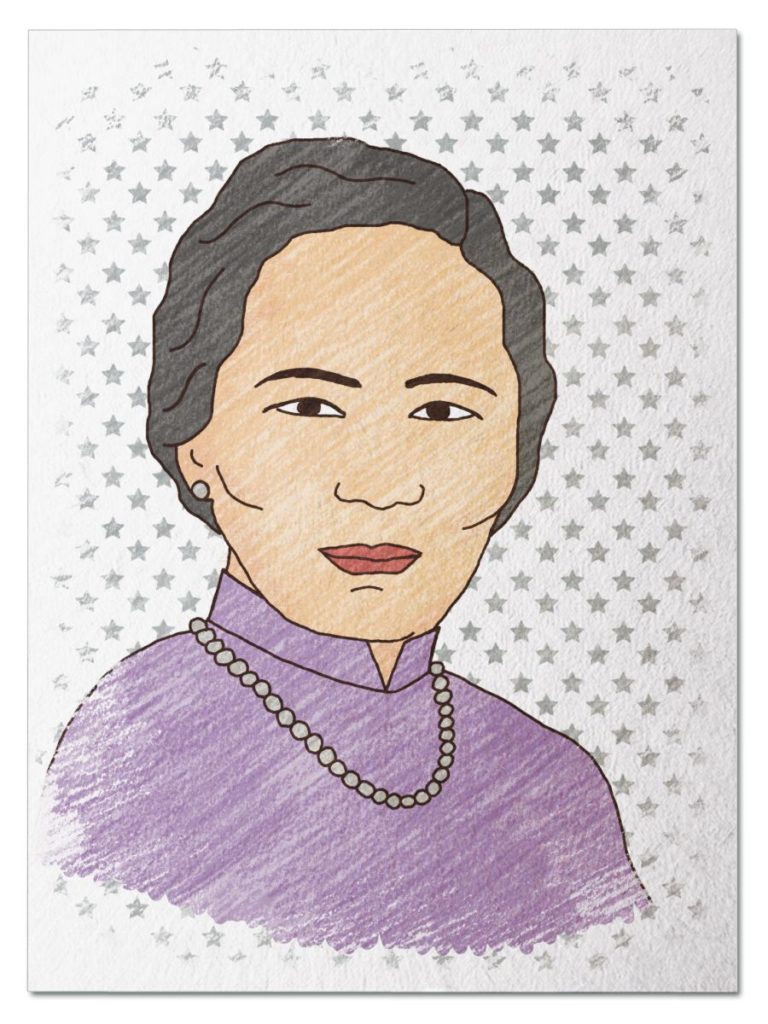
Super Scientist
When she was 24, she left her entire life behind in China to study physics at an American university. She arrived in the middle of the Great Depression and lost contact with her family for 8 years during WWII. She opened doors with her science skills to become the first woman faculty member at Princeton and part of the Manhattan Project. She challenged conventional knowledge by designing experiments to disprove the accepted laws of physics. Twenty years after she arrived in the USA, her Wu Experiment disproved The Law of the Conservation of Parity, and the two male scientists she worked with won the Nobel Prize. Join Chien-Shung Wu on a snowy day in 1956 as she realizes what she has discovered…
Her Ruby Shoe Moment
The Power of the Wand
Her Yellow Brick Road
Brains, Heart & Courage
Glinda’s Gallery
Just the Facts
Her Ruby Shoe Moment
Chien-Shiung Wu rushed into the Union Depot in Washington DC. It was a snowy Christmas Eve in 1956 and she was trying to catch the last train bound for New York City. As Wu boarded the train and settled into her seat, the magnitude of her discovery sank in.
Wu had just completed a science experiment that disproved one of the “laws of physics.” Wu tried to get the experiment done as quickly as possible, because she knew other scientists were working on the same question. She did the experiment over and over, changing variables and confirming the findings. It was a race to publish the results first.
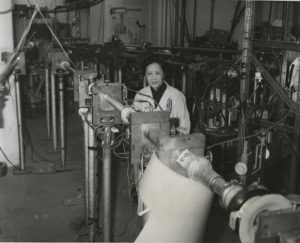
Smithsonian Institute Archives
It all started six months earlier, when scientists Tsung-Dao Lee and Chen-Ning Yang asked Wu to design a groundbreaking experiment. They had a new theory and needed someone to help them either confirm or disprove it. Wu couldn’t pass up the opportunity. She and her husband had been planning a visit to China, but she cancelled her trip and got to work (her husband went without her). It was quite a sacrifice — she hadn’t been back to China since she arrived in America 20 years earlier.
Lee and Yang questioned whether the law of physics — “The Law of the Conservation of Parity” — was universal. The Conservation of Parity stated that identical particles will act the same, and that two physical systems will work as mirror images of each other. In general, atoms take the path of least resistance and had no tendency to spin either right or left. For years, the scientific community assumed that the Conservation of Parity applied in all situations.
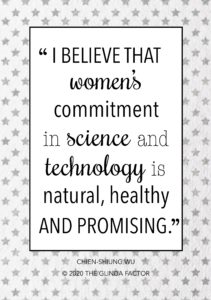 Wu designed a complicated experiment to test whether the Conservation of Parity applied during beta decay. She conducted the experiment at the National Bureau of Standards facility in Washington DC, since it had the super-cooling equipment that was required. Wu planned everything, down to the smallest detail. She designed the machines for the experiment, wrote the laboratory procedures, and created the guidelines for measuring the results.
Wu designed a complicated experiment to test whether the Conservation of Parity applied during beta decay. She conducted the experiment at the National Bureau of Standards facility in Washington DC, since it had the super-cooling equipment that was required. Wu planned everything, down to the smallest detail. She designed the machines for the experiment, wrote the laboratory procedures, and created the guidelines for measuring the results.
Wu used a sample of radioactive cobalt and cooled it to an extremely low temperature. The cold temperature slowed down the atoms enough so that Wu could document their movement. If Conservation of Parity applied, there should be an equal number of atoms spinning right and left.
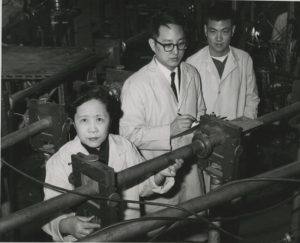
Smithsonian Institute Archives
But the numbers were not equal. Wu’s experiment disproved the Law of Conservation of Parity. She provided evidence that atoms have a preference for the direction in their spin. In beta decay, atoms preferred to spin to the left (they were left-handed, so to speak). And her painstaking work confirmed Yang and Lee’s theory.
Wu’s findings stunned the science world. Before long, the “Wu Experiment” was reproduced in labs around the world. In October of 1957, Yang and Lee received word that were awarded the Nobel Prize for their work on the Law of Conservation of Parity. The Nobel Committee didn’t include Wu in the award, however, even though her experiment provided the factual evidence of the theory.
The Power of the Wand
This past week, Dr. Emmanuelle Charpentier and Dr. Jennifer Doudna achieved what was denied Wu — they were jointly awarded the Nobel Prize in chemistry. Back in 2012, they worked together to develop a genetic tool called Crispr-Cas9. It’s like a genetic scissors, which allows for the precise isolation and editing of individual genes. Today, it’s used in surgeries and treatments for genetic diseases, such as sickle cell disease, as well as experimental cancer therapies.
Many teen girls have built on Wu’s legacy over the years. When she was 15 years old, Anastasia Roda became concerned that nuclear power plants affect he ecosystem of neighboring bodies of water. So she conducted research in Barnegat Bay, which is close to the Oyster Creek Generating Station, a nuclear power plant in New Jersey. And she found that the water near the nuclear power plant was warmer, had faster currents, and higher bacterial levels than other bodies of water. In 2012, Anastasia was recognized in Discover Magazine for her work.
Her Yellow Brick Road
In summer of 1936, Wu boarded the SS President Hoover and took the one week journey across the Pacific Ocean. She landed in San Francisco and planned to attend a graduate program at the University of Michigan that fall. But she never made it.
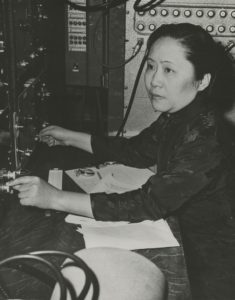
Smithsonian Institute Archives
Wu had a few weeks before the semester started, so she contacted the physics department at UC Berkeley. She impressed the head of the department, professor Ernest Lawrence, who offered her a position in the graduate program. And she decided to stay.
It was a dream come true for Wu. She had an opportunity to study under some of the most brilliant minds in physics at the time, Ernst Lawrence and Robert Oppenheimer. Lawrence built a new particle accelerator (a machine that used magnetic fields to speed up particles and smash them together). During her graduate work, Wu focused on designing experiments to test various theories in physics.
Adapting to life in America was hard. The English language was difficult. And she missed everything about home, especially her family, the food, and the culture. In fact, she wore traditional Chinese clothing her entire life underneath her lab coat. And she worried about her family constantly, since China was invaded by Japan in 1937 (less than one year after she left). She couldn’t communicate with them for 8 years.
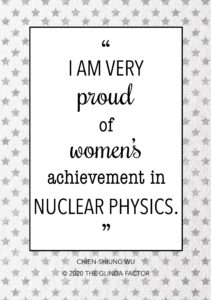 Wu completed her PhD in 1940. By then, she had a reputation as an expert on nuclear fission (splitting atoms through nuclear reaction or radioactive decay). She worked long hours and was very exacting in her work. Then, she married a fellow graduate student and moved to the East Coast in 1942. It was tough for her to find a job, however. She faced both gender discrimination and ethnic racism. Wu finally found a position as assistant professor at Smith College, but wan’t very happy there.
Wu completed her PhD in 1940. By then, she had a reputation as an expert on nuclear fission (splitting atoms through nuclear reaction or radioactive decay). She worked long hours and was very exacting in her work. Then, she married a fellow graduate student and moved to the East Coast in 1942. It was tough for her to find a job, however. She faced both gender discrimination and ethnic racism. Wu finally found a position as assistant professor at Smith College, but wan’t very happy there.
Then, America entered World War II. America’s prestigious universities faced a crisis — many of the male professors left to help the war effort and there was a shortage of teachers. Given the dire circumstances, universities were willing to hire women (even though they still didn’t admit woman as students). As a result, Wu became the first woman on faculty at Princeton University.
 Before long, Wu was invited to join the Manhattan Project. They met in secret at a warehouse in New York City that was owned by Columbia University. Wu was involved at the highest levels of the Manhattan Project, working with the technical aspects of creating an atomic bomb. Her job was to figure out how to enrich uranium and use it as fuel for the nuclear reaction in the bomb.
Before long, Wu was invited to join the Manhattan Project. They met in secret at a warehouse in New York City that was owned by Columbia University. Wu was involved at the highest levels of the Manhattan Project, working with the technical aspects of creating an atomic bomb. Her job was to figure out how to enrich uranium and use it as fuel for the nuclear reaction in the bomb.
Wu left the Manhattan Project after the atomic bomb was dropped on Japan and World War II ended. She was hired as the first woman professor in the physics department at Columbia University. While at Columbia, she changed history by conducting the Wu Experiment.
Brains, Heart & Courage
Wu was born in China during a time of great change. The Republic of China was only a year old. But many of the old views and traditions still permeated society. For example, girls were still forbidden to get an education when Wu was born. Instead, they were expected to prepare for marriage and bind their feet.
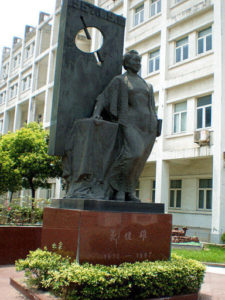
Statue Honoring Chien-Shiung Wu in Shanghai, China
Thankfully, that changed. And Wu’s father was one of the leaders that brought about the change. In fact, both her parents were dedicated to education and equal rights for women. Her mother was a teacher and her father was an engineer. So her father started their community’s first school for girls — the Mingde Women’s Vocational Continuing School.
Wu was one of first girls to get a formal education in China. Eventually, she learned all she could at her father’s school. So she left for boarding school when she was 10 years old. The Suzhou Girl’s School was about 50 miles from home, but felt like another world. While there, she fell in love with math and science. Wu attended boarding school for 7 years, learning all she could and working as hard as she could. And she graduated from its high school program in 1930.
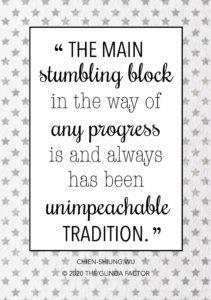 Her goal was to continue her studies in math and science. Thankfully, all her hard work paid off and she met her goal — she was admitted to National Central University in Nanjing. Wu was originally a math major, but then switched to physics a few years later.
Her goal was to continue her studies in math and science. Thankfully, all her hard work paid off and she met her goal — she was admitted to National Central University in Nanjing. Wu was originally a math major, but then switched to physics a few years later.
Wu went on to graduate at the top of her class from Nanking University in 1934. And she wanted to continue her studies. Unfortunately, there were no graduate programs in physics in China. So she decided to continue her education in America. Wu applied to graduate schools in America and was accepted by the University of Michigan. It was a big step to travel across the ocean alone and leave all her family behind. And expensive. Luckily, her uncle helped to pay for the ship passage and university tuition. She was on her way towards making history!
Glinda’s Gallery
Just the Facts
- Wu was born May 31, 1912 in a small town 30 miles northwest of Shanghai, China. She was the middle of three kids and had 2 brothers.
- Wu married fellow scientist, Luke Yuan, and they had a son named Vincent in 1947.
- Wu was the first woman to serve as president of the American Physical Society. She also wrote a textbook, Beta Decay, in 1965, which is still a standard reference book today.
- In 1990, Wu was the first living scientist to have an asteroid named after her — “Asteroid 2752 Wu Chien-Shiung.”
- Wu focused on educational STEM programs for girls in China, Taiwan, and America.
- Wu died of a stroke on February 16, 1997 at age 84.
- After her death, Wu’s husband and colleagues founded the Wu Chien-Shiung education foundation scholarship program in Taiwan.
- Even though Wu was never acknowledged by the Nobel Committee, she received an impressive number of awards over her career:
- Earned Research Corporation award in 1958
- John Price Wetherill Medal of the Franklin Institute in 1962
- National Academy of Science’s Comstock Award in Physics in 1964
- Scientist of the Year by Industrial Research Magazine in 1974
- Bonner Prize of the American Physical Society in 1974
- National Medal of Science in 1975
- Wolf Prize in Physics in 1978
- Inducted into American National Women’s Hall of Fame in 1998
- Wu was honored in China as well — she is known as “chien-shiung: courageous hero.” In 1990, the Chinese Academy of Science named Asteroid 2752 in her honor. Then, on the 100th anniversary of her birth (May 31, 2012) she was honored in her hometown in China with a memorial ceremony.
Want to Know More?
“Landmarks—Breaking the Mirror.” Phys. Rev. Focus, December 2, 2008 (accessed at https://physics.aps.org/story/v22/st19)
“Celebrating Women in STEM: Dr. Chien-Shiung Wu.” Physics @ Berlekey. September 5, 2017 (accessed at https://www.atomicheritage.org/profile/chien-shiung-wu)
“Chien-Shien Wu.” National Science & Technology Medals Foundation (accessed at https://www.nationalmedals.org/laureates/chien-shiung-wu).
“Chien-Shiung Wu (1912-1997).” National Scientific Women (accessed at https://www.nsf.gov/news/special_reports/medalofscience50/wu.jsp).
“Chien-Shien Wu.” History of Science & Technology Medals Foundation (accessed at https://www.scientificwomen.net/women/wu-chien-shiung-94
“Dr. Chien-Shiung Wu, The First Lady of Physics.” National Park Service (accessed at https://www.nps.gov/people/dr-chien-shiung-wu-the-first-lady-of-physics.htm)
Debesky, Dale. “Parity Can Be Deceiving: The Razor-Sharp Physics of Chien-Shiung Wu.” Women You Should Know, June 27, 2018. (accessed at https://womenyoushouldknow.net/razor-sharp-physics-chien-shiung-wu/)
Noble, Iris. Contemporary Women Scientists of America. New York: Julian Messner, 1979.
Tsai-Chien Chiang. Madame Wu Chien-Shiung: The First Lady of Physics Research. World Scientific Publishing Company, 2013.
Vare, Ethlie Ann and Greg Ptacek. Mothers of Invention: from the bra to the bomb, forgotten women & their unforgettable ideas. New York: Morrow, 1988.
Wu, C.S. et.al., “Experimental Test of Parity Conservation in Beta Decay.” Journal of Physics Review, January 15, 1957 (accessed at https://journals.aps.org/pr/pdf/10.1103/PhysRev.105.1413)
